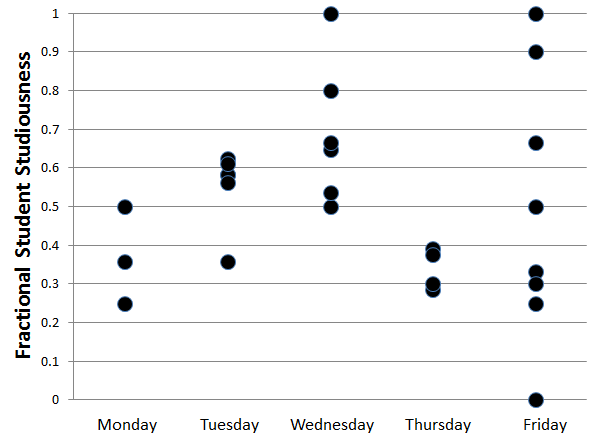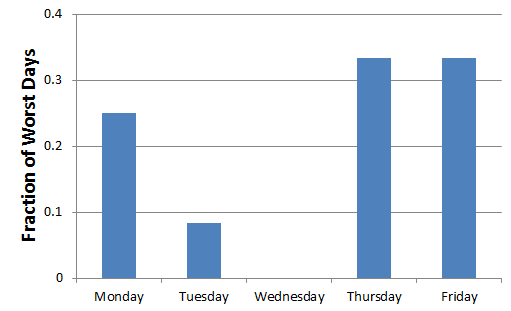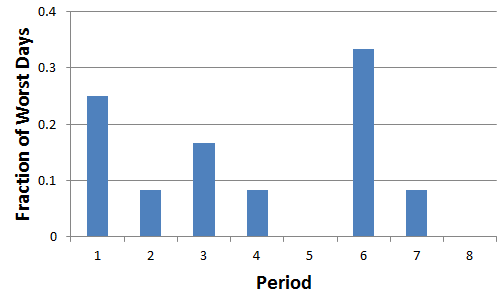My school has an addiction to study halls. They are used to pad out the master schedule for students in our middle school. By the time they get to grade 11, our students might even have half a day in study hall.
Unfortunately, value of this self-directed time is unclear. In spite of a school policy that requires students either do classwork or read a book, students often spend their study hall time watching videos, chatting with friends, and neglecting their schoolwork. Policing study halls is difficult for the monitors because the students see study hall as “their” time, and resent being told what to do.
In order to gain a better understanding of how the students were using their study halls, I conducted a three-week study that visited 30 study hall classes. For as many study hall periods as possible, I dropped by and categorized each student accordingly:
Fully On-Task: The student is currently working on an assignment and clearly focused on his/her task. If the student is working with a peer, their discussion must be tightly bound to their assignment.
Distracted: The student has work out, but is not fully focused on the task. Distractions include chatting with peers or teachers, viewing non-task-related material on a computer, and using a phone.
No Work: There is no evidence of the student attempting to work on a school assignment during this period.
The pie chart above depicts how students used the study halls during this investigation. Each student in each study hall is counted equally.
To compile and compare the data, I calculated a quantity called fractional studiousness, as follows. Fractional studiousness is a measure of the usefulness of a study hall period.
My colleague suggested that the students often arrive on Monday with their homework completed and that they do little on Friday because due dates are several days away. I’d add that, on occasion, students have assignment deadlines extended until the end of the day on Friday — this might explain the large variability in studiousness on that day. Figure 2 shows a classic depiction of the “hump”-shaped workweek.
I was also curious about how students performed in their study halls over the course of a day. In figure 3, you can see lower performance in the afternoon, perhaps attributable to post-lunch sleepiness. There’s also a hint of lazy mornings.
Another way to slice these data is to isolate the worst study hall blocks. In this study, there were 12 worst study halls that have a studiousness of 0.4 or less. All the others have a studiousness of at least 0.5. Note that some of the data points in figures 3 and 4 coincide.
In the week-long view, the trend toward a mid-week efficiency “hump” is retained. The day-long graph shows ineffective mornings, and mid-afternoon blahs.
I was also curious about the role of technology in studiousness during study halls. Naively, one might suggest that computers offer students a plethora of ways to be distracted. For the purpose of this study, I counted laptop computers and tablets (iPad, etc) but not smartphones (iPhone). My belief is that the former is typically viewed as a tool (for writing essays, researching, reading electronic texts, etc) while the latter is typically viewed as a communication and entertainment device.
Figure 6 shows comparisons of the same study hall on two different weeks. This should offer a control against the studiousness of individual students. For example, the red line shows a particular group of students had a studiousness of 0.5 on a week when 20% had computers, and a lower studiousness of 0.2 on a week when 50% had computers. In this case, we can infer that more computers means more distraction.
However, the overall trend is the opposite: of the 9 study halls for which I was able to obtain data, 6 show a positive correlation between computer use and studiousness (and 1 is agnostic). In other words, more computers means more students working. The two exceptional study halls are populated primarily by a small group of 11th-grade students new to our school.
This phenomenon can be explained by the fact that much of the students’ work requires the use of computers. When students don’t have computers available, they allow themselves to become distracted by other factors, such as their phones or chatting with others.
Conclusions:
- Study hall time is being used effectively only 30% of the time.
- 28% of study hall periods are used for non-academic purposes.
- Distractions are a key problem for study halls.
- The midweek is used more efficiently than Monday and Thursday. Friday is used effectively by some students, perhaps because of end-of-week deadlines.
- Study halls are more productive in the morning. Block 6 (also called block 3B at our school) is particularly ineffective.
- Generally, computer use in study halls correlates with improved studiousness. To improve the usefulness of study halls, the school should ensure students have computers available for use during study hall periods.






